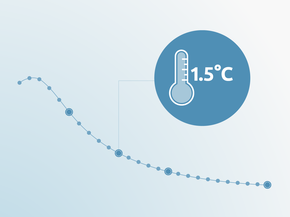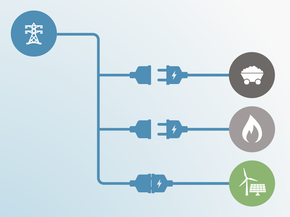Critically Insufficient4°C+
World
NDCs with this rating fall well outside of a country’s “fair share” range and are not at all consistent with holding warming to below 2°C let alone with the Paris Agreement’s stronger 1.5°C limit. If all government NDCs were in this range, warming would exceed 4°C.
Highly insufficient< 4°C
World
NDCs with this rating fall outside of a country’s “fair share” range and are not at all consistent with holding warming to below 2°C let alone with the Paris Agreement’s stronger 1.5°C limit. If all government NDCs were in this range, warming would reach between 3°C and 4°C.
Insufficient< 3°C
World
NDCs with this rating are in the least stringent part of a country’s “fair share” range and not consistent with holding warming below 2°C let alone with the Paris Agreement’s stronger 1.5°C limit. If all government NDCs were in this range, warming would reach over 2°C and up to 3°C.
2°C Compatible< 2°C
World
NDCs with this rating are consistent with the 2009 Copenhagen 2°C goal and therefore fall within a country’s “fair share” range, but are not fully consistent with the Paris Agreement long term temperature goal. If all government NDCs were in this range, warming could be held below, but not well below, 2°C and still be too high to be consistent with the Paris Agreement 1.5°C limit.
1.5°C Paris Agreement Compatible< 1.5°C
World
This rating indicates that a government’s NDCs in the most stringent part of its “fair share” range: it is consistent with the Paris Agreement’s 1.5°C limit.
Role model<< 1.5°C
World
This rating indicates that a government’s NDC is more ambitious than what is considered a “fair” contribution: it is more than consistent with the Paris Agreement’s 1.5°C limit.
Sources
List of references
- Aizhu, C. (2018, February 5). China’s soaring natural gas output unable to meet demand set loose in pollution fight. Reuters. Retrieved from article/us-china-pollution-gas-production/chinas-soaring-natural-gas-output-unable-to-meet-demand-set-loose-in-pollution-fight-idUSKBN1FP006
- Boden, T., & Andres, B. (2016). National CO2 Emissions from Fossil-Fuel Burning, Cement Manufacture, and Gas Flaring: 1751-2013. Retrieved February 20, 2017, from http://cdiac.ornl.gov/ftp/ndp030/nation.1751_2013.ems
- China Daily. (2015, June 1). Made in China 2025 strategy for auto industry. Retrieved from http://english.gov.cn/policies/infographics/2015/06/02/content_281475119391820.htm
- Enerdata. (2016). China confirms ban on new coal-fired power plant construction until 2018. Retrieved September 27, 2016, from http://www.enerdata.net/enerdatauk/press-and-publication/energy-news-001/china-confirms-ban-new-coal-fired-power-plant-construction-until-2018_37678.html
- Energy Research Institute of the National Development and Reform Commission. (2015). China 2050 High Renewable Energy Penetration Scenario and Roadmap Study. https://doi.org/10.1002/ejoc.201200111
- Frankfurt School-UNEP Centre/BNEF. (2018). Global Trends in Renewable Energy Investment 2018. Retrieved from https://drive.google.com/file/d/1SmhaI-WAcmEMqR8R9oL5Fxn0cZ0kfY8Z/view
- Gordon, K., & Hove, A. (2016, September 13). How China Wastes Its Renewable Energy. Retrieved from http://blogs.wsj.com/experts/2016/09/13/how-china-wastes-its-renewable-energy/
- IEA. (2016). Energy Technology Perspectives 2016. Paris, France: International Energy Agency. Retrieved from http://www.iea.org/etp/etp2016/
- IEA. (2017a). World Energy Outlook 2017. Paris, France: International Energy Agency. Retrieved from https://www.iea.org/weo2017/
- IEA. (2017b). World Energy Statistics and Balances. 2017 Edition. Paris, France, France: International Energy Agency.
- IEA. (2018). Global Energy & CO2 Status Report 2017. Retrieved from http://www.iea.org/publications/freepublications/publication/GECO2017.pdf
- IMF. (2017). World Economic Outlook (October 2017) - Real GDP growth. Retrieved March 1, 2018, from http://www.imf.org/external/datamapper/NGDP_RPCH@WEO/KAZ
- Jotzo, F., Karplus, V., Grubb, M., Loeschel, A., Neuhoff, K., Wu, L., & Teng, F. (2018). China’s emissions trading takes steps towards big ambitions. Nature Climate Change, 8, 260–271. Retrieved from https://www.nature.com/articles/s41558-018-0130-0.epdf?author_access_token=Xi5UzVwwhX6tiJ5u301kfdRgN0jAjWel9jnR3ZoTv0Mgl1oK5YdFJyrQdS-KFGiJCU7UMJKtWYtn6OKSpg9qYSKqj0e1wf6V-fEKd2EwGLXjdwj8vG71sbe8oMdBymvlI9730VF1is-t6XdIQ2Kx1g%3D%3D
- JRC, & PBL. (2014). EDGARv4.2FT2012. European Commission Joint Research Centre (JRC) and the Netherlands Environmental Assessment Agency (PBL). Retrieved from http://edgar.jrc.ec.europe.eu
- Korsbakken, J. I., & Peters, G. (2017). A closer look at China’s stalled carbon emissions. Retrieved March 30, 2017, from http://www.carbonbrief.org/guest-post-closer-look-chinas-stalled-carbon-emissions
- Lin, A. (2017). Understanding China’s New Mandatory 58% Coal Cap Target. Retrieved from https://www.nrdc.org/experts/alvin-lin/understanding-chinas-new-mandatory-58-coal-cap-target
- National Bureau of Statistics of China. (2017a). China Statistical Yearbook 2017. Retrieved from http://www.stats.gov.cn/tjsj/ndsj/2017/indexeh.htm
- National Bureau of Statistics of China. (2017b). Statistical Communiqué of the People’s Republic of China on the 2016 National Economic and Social Development. Retrieved March 31, 2017, from http://www.stats.gov.cn/english/PressRelease/201702/t20170228_1467503.html
- NDRC. (2016). 能源发展“十三五”规划. Retrieved from http://www.ndrc.gov.cn/zcfb/zcfbghwb/201701/W020170117350627940556.pdf
- NEA. (2017). 国家能源局关于可再生能源发展 “十三五”规划实施的指导意见 (Guidance of the National Energy Administration on the Implementation of the 13th FYP for Renewable Energy Development). Retrieved August 20, 2017, from http://zfxxgk.nea.gov.cn/auto87/201707/t20170728_2835.htm
- NEA. (2018). 煤炭也能烧出低排放.
- People’s Republic of China. (2016). 中华人民共和国气候变化 第一次两年更新报告 (People’s Republic of China’s First Biennial Update Report on Climate Change). Retrieved from http://unfccc.int/files/national_reports/non-annex_i_parties/biennial_update_reports/submitted_burs/application/pdf/chnbur1.pdf
- Peters, G. (2017). Have Chinese CO2 emissions really peaked? Retrieved April 25, 2017, from http://www.climatechangenews.com/2017/03/31/chinese-co2-emissions-really-peaked/
- Platts. (2018). Factbox: China’s 2018 targets for energy and steel sectors. Retrieved from https://www.platts.com/latest-news/oil/singapore/factbox-chinas-2018-targets-for-energy-and-steel-27936461
- Pontes, J. (2018, January 29). 2017 China Electric Car Sales Blow World Out of the Water - BAIC EC-Series is a Superstar. Clean Technica. Retrieved from https://cleantechnica.com/2018/01/29/2017-china-electric-car-sales-blow-world-water-baic-ec-series-superstar/
- Qi, Y., Stern, N., Wu, T., Lu, J., & Green, F. (2016). China’s post-coal growth. Nature Geoscience. https://doi.org/doi:10.1038/ngeo2777
- Shirouzu, N., & Jourdan, A. (2017, September 28). China sets 2019 deadline for automakers to meet green-car sales targets. Reuters. Retrieved from https://www.reuters.com/article/us-autos-china-electric/china-sets-2019-deadline-for-automakers-to-meet-green-car-sales-targets-idUSKCN1C30ZL
- UNFCCC. (2017). Greenhouse Gas Inventory Data. Bonn, Germany: United Nations Framework Convention on Climate Change. Retrieved from http://di.unfccc.int/DetailedDataByParty.aspx
- Xinhua. (2017). Beijing’s last large coal-fired power plant suspends operations. Retrieved March 31, 2017, from http://news.xinhuanet.com/english/2017-03/18/c_136139334.htm
- Yan, J., & Myllyvirta, L. (2017). China has already surpassed its 2020 solar target. Retrieved August 30, 2017, from http://energydesk.greenpeace.org/2017/08/25/china-raises-solar-power-target/
Further analysis
Latest publications
Stay informed
Subscribe to our newsletter






